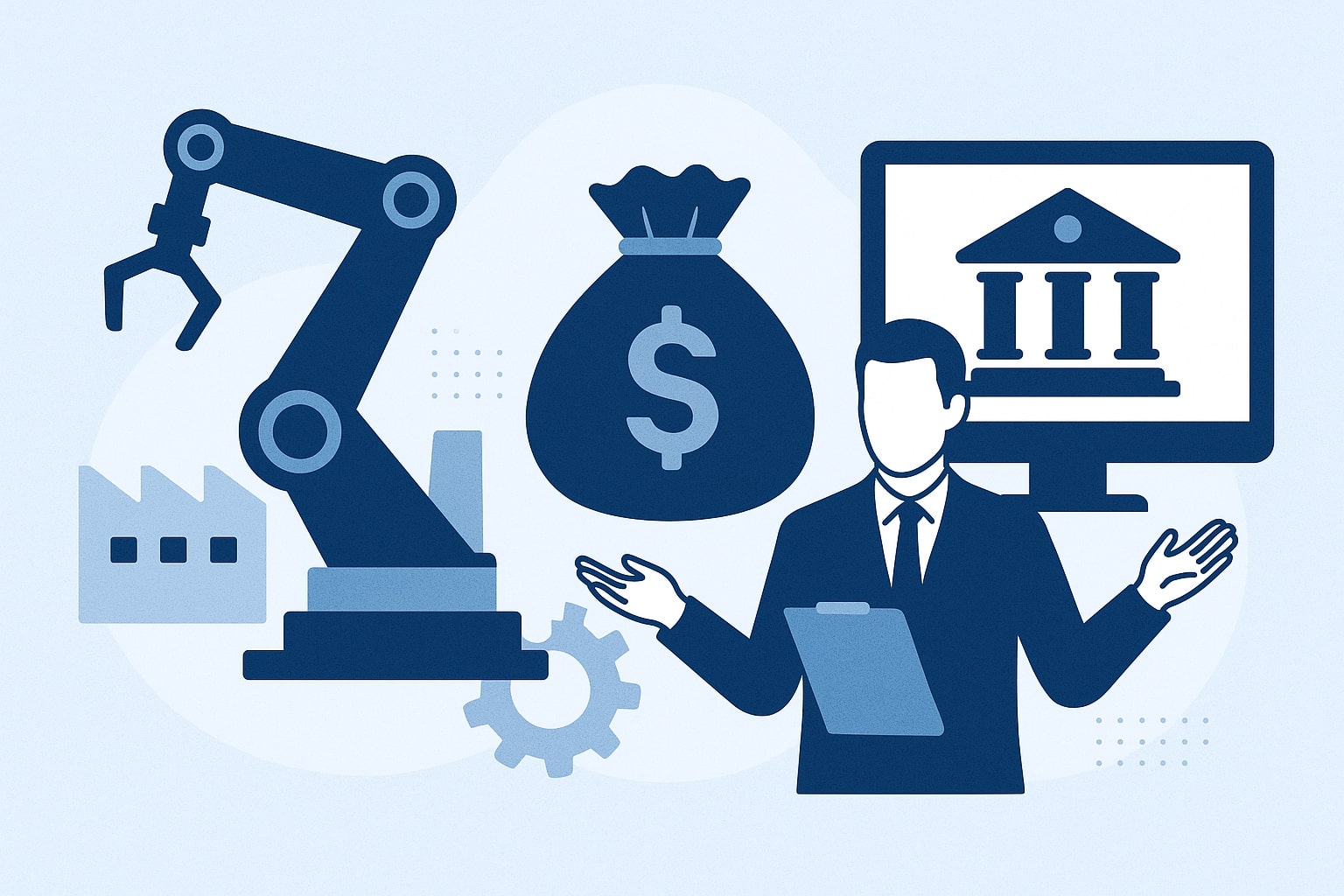
Equipment Loans for Manufacturing Businesses
Equipment loans for manufacturing businesses are purpose-built financing that help U.S. manufacturers acquire, replace, or retrofit machinery without draining working capital.
In practical terms, these loans turn high-ticket assets—CNC machines, injection molders, additive manufacturing printers, forklifts, robotics, packaging lines—into manageable monthly payments.
Compared with general-purpose term loans, equipment loans for manufacturing businesses are typically secured by the equipment itself, which can mean faster credit decisions, longer amortization, and lower interest rates relative to unsecured credit.
That structure keeps cash free for payroll, raw materials, and inventory carrying costs—critical in plants where lead times, seasonality, or OEM backlogs already stress cash flow.
Because equipment is a productivity engine, financing it strategically can move multiple needles at once: throughput, scrap rates, uptime, and margins. Well-structured equipment loans for manufacturing businesses also create a predictable total cost of ownership (TCO), especially when bundled with warranties, maintenance, and installation.
For U.S. shops that must modernize to win reshoring work, comply with OSHA and EPA standards, or satisfy automotive, aerospace, and medical device QA requirements, access to the right loan product can be the difference between landing a contract and sitting on the sidelines.
Finally, financing intersects with taxes. In 2025, Section 179 expense and bonus depreciation (recently updated by federal legislation) can dramatically improve after-tax economics on qualifying equipment placed in service this year.
When you pair the right loan with the right tax strategy, equipment loans for manufacturing businesses can generate a cash-on-cash return that exceeds the loan’s interest cost.
How Equipment Loans for Manufacturing Businesses Work (Structure, Terms, Collateral)
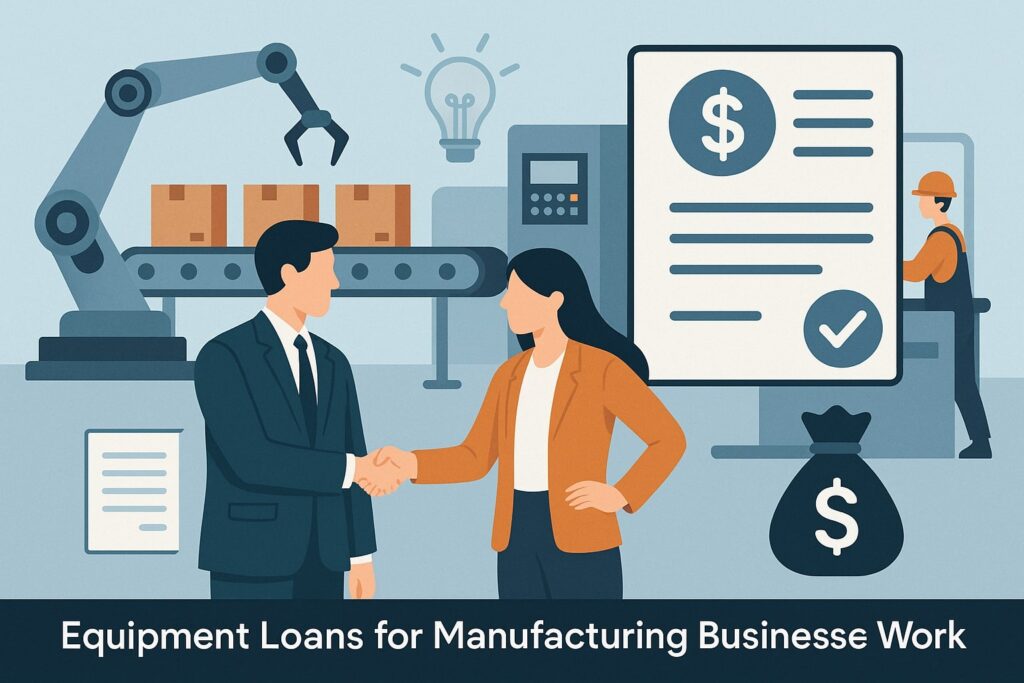
At their core, equipment loans for manufacturing businesses are asset-based. The lender perfects a security interest—often via a UCC-1 filing—to claim the machinery as collateral. That security interest typically results in better pricing than unsecured borrowing, while preserving other collateral (like real estate) for different needs.
Expect lenders to file a UCC-1 with your state’s Secretary of State describing the collateral; once paid off, they file a UCC-3 termination. This process protects the lender’s priority in a default and signals to future creditors that the asset is encumbered.
Terms usually range from 36 to 84 months (sometimes longer for heavy, long-life assets). Down payments vary by credit and asset class, commonly 0%–20%. Payments can be level, seasonal (to match production peaks), or step-up (lighter at first while the asset ramps). Interest can be fixed or variable (often benchmarked to SOFR or Prime).
Many lenders offer add-ons—soft costs like installation, rigging, shipping, and sales tax can often be rolled into the financing so you’re not writing multiple checks during commissioning.
Underwriting focuses on time in business, leverage, DSCR (debt service coverage ratio), cash flow consistency, personal and business credit, industry risk, and secondary market value of the equipment.
For startups or distressed shops, lenders may ask for additional collateral, a personal guarantee, or larger down payment. But for established manufacturers with predictable purchase orders, equipment loans for manufacturing businesses can be approved quickly when backed by strong financials and the equipment’s liquidation value.
The 2025 Tax Landscape: Section 179 and Bonus Depreciation you Can Use
Taxes meaningfully change the ROI on equipment loans for manufacturing businesses. For tax years beginning in 2025, the IRS increased Section 179 spending limits. The maximum Section 179 expense deduction is $1,250,000 for 2025, reduced dollar-for-dollar when total Section 179 property placed in service exceeds $3,130,000.
Qualifying property must be placed in service (installed and ready for use) in the tax year. Section 179 is further limited to your active trade or business taxable income, and special limits apply to SUVs. Manufacturers often combine Section 179 with regular MACRS to optimize deductions when income is insufficient to absorb the full expense.
Bonus depreciation rules also changed. Historically, the Tax Cuts and Jobs Act scheduled bonus depreciation to phase down to 40% in 2025.
However, new 2025 legislation—commonly described by firms as part of the “One Big Beautiful Bill Act (OBBBA)”—reinstated 100% bonus depreciation for qualified property acquired and placed in service after January 19, 2025, with a transitional election that allows taxpayers to apply the pre-existing phase-down (40%/60% for certain long-production or aircraft property) for the first taxable year ending after that date.
Leading national tax advisories have summarized these updates and the transition mechanics for acquisition date and binding contracts. Always confirm with your CPA how the law applies to your facts, including binding contract timing, self-constructed property rules, and placed-in-service tests.
SBA Options: 7(a) vs. 504 for Equipment-heavy Manufacturers
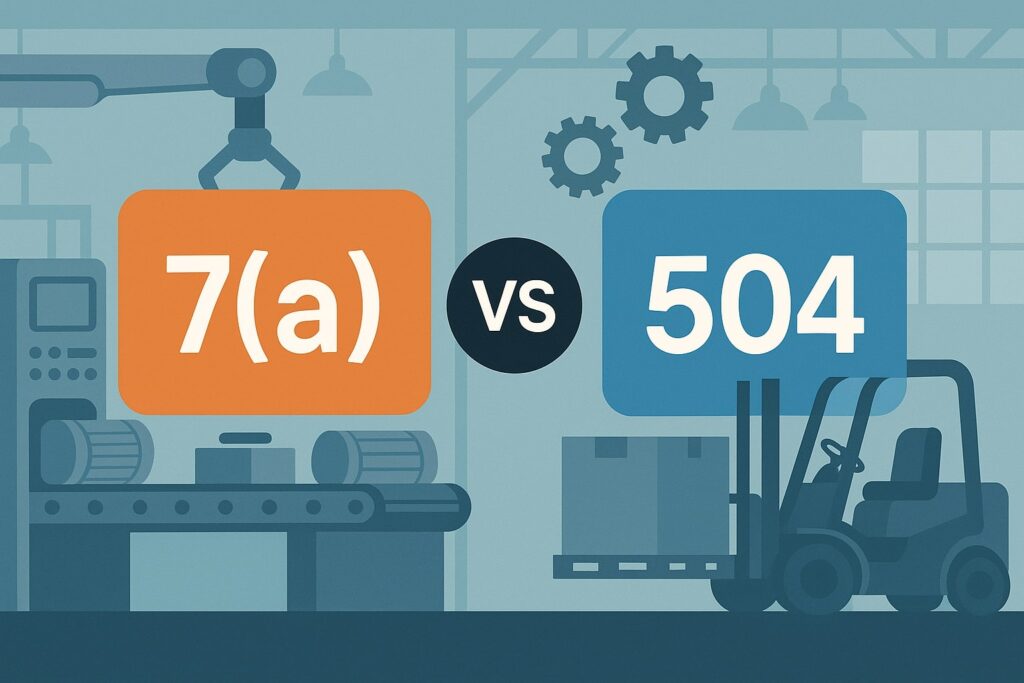
When bank credit is tight or you want longer terms, SBA-enhanced loans are go-to tools for equipment loans for manufacturing businesses.
- SBA 7(a). The flagship 7(a) program supports general business purposes, including equipment purchases. The standard maximum loan amount is $5 million, with SBA guarantees up to $3.75 million depending on subtype.
Interest rates are negotiated with lenders within SBA caps; maturities for equipment commonly stretch to 10 years (sometimes up to the useful life). The 7(a) route is flexible and fast with SBA Express (lower caps), useful if equipment is only part of your need (working capital + equipment). - SBA 504. The 504 program shines for major fixed assets—machinery, equipment, and owner-occupied industrial real estate—using a 50/40/10 structure (bank first lien ~50%, CDC/SBA second lien debenture ~40%, borrower equity ~10%, with additional equity for start-ups or special-use).
The maximum SBA-backed debenture is generally $5 million and up to $5.5 million for certain projects, including some manufacturing and energy efficiency investments. The 504 debenture carries a long, fixed rate (10, 20, or 25 years) that pairs nicely with long-life assets.
If you’re adding a line and expanding your plant, you can combine 504 for the real estate and heavy equipment into one capital plan.
Which to choose? If you need flexibility (mixed uses, working capital, inventory), 7(a) is versatile. If you want the longest fixed rate and largest equipment ticket with modest equity, 504 is built for it. Either way, SBA can be layered with Section 179 and bonus depreciation to enhance after-tax cash flow on equipment loans for manufacturing businesses.
Leasing vs. Loans: Which Structure Fits your Plant?
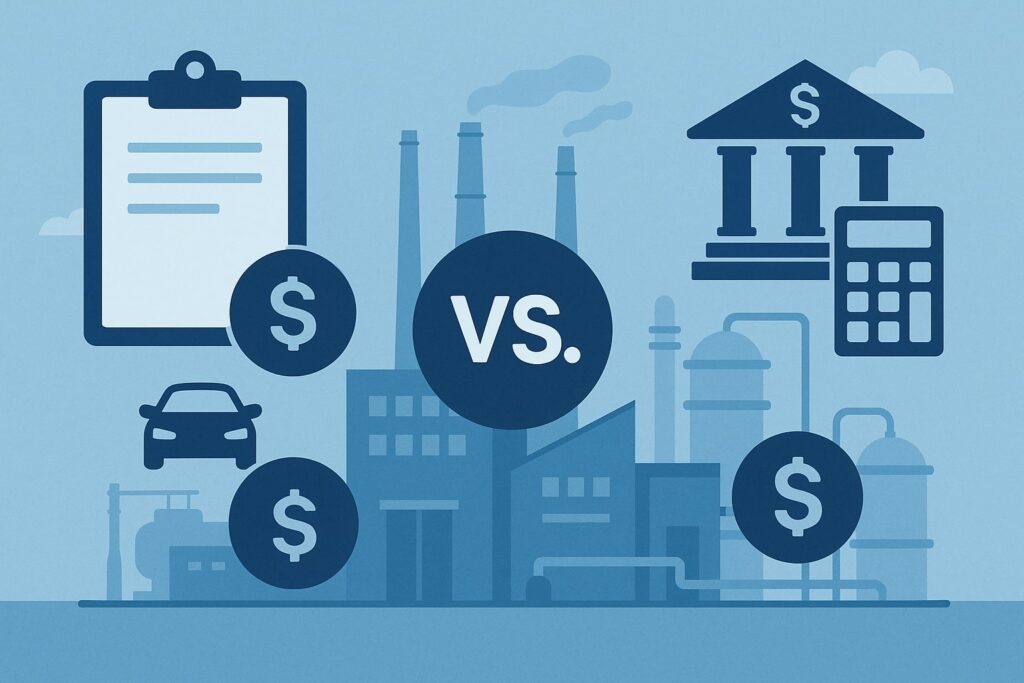
Manufacturers often compare finance leases, $1 buyouts, and true leases (FMV end-of-term) against classic equipment loans for manufacturing businesses. A loan places the asset on your balance sheet; you depreciate it (and potentially use Section 179/bonus).
A true lease may keep the asset off the balance sheet under certain thresholds or accounting treatment, but tax and GAAP have diverged—consult your CPA on ASC 842 treatment.
Leases can deliver lower initial payments and keep upgrade flexibility, which is useful for fast-evolving technologies (vision systems, cobots, inspection gear). Loans are cleaner when you intend to own long-life assets through their economic life (presses, mills, ovens).
The cost comparison should include rate, residual assumptions, fees, maintenance, uptime guarantees, and the tax position under Section 179/bonus depreciation.
With 100% bonus depreciation available on qualifying assets placed in service after January 19, 2025 (subject to the statute and transition rules), loans may now deliver superior after-tax economics versus some leases, depending on structure.
That’s why many plants adopt a portfolio approach—loan long-life core machines and lease rapidly evolving tech.
Qualification Checklist for Equipment Loans for Manufacturing Businesses
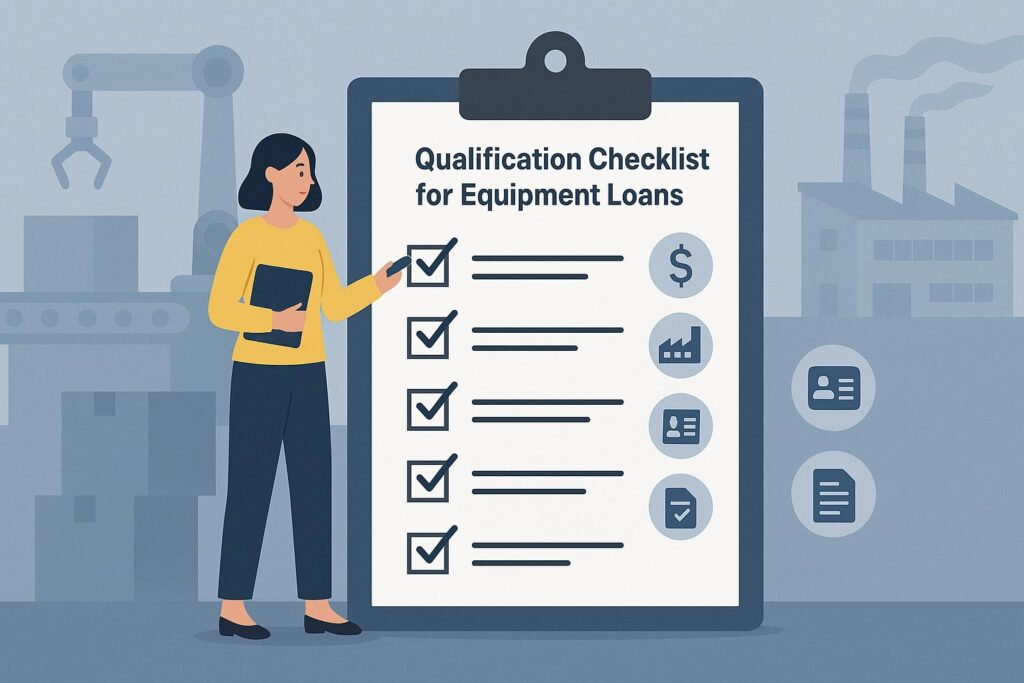
Before you apply, assemble a lender-ready package:
- Financials: Last two to three years of business tax returns and CPA-prepared financial statements; YTD interim financials; AR/AP aging; backlog and purchase orders to show pipeline.
- Debt Schedule & DSCR: A current debt schedule and a 12-to-24-month cash flow projection reflecting the new payment. Lenders key on DSCR ≥ 1.25x.
- Equipment Quote: OEM/Seller quote itemizing base unit, options, installation, freight, training, and sales tax. This helps roll “soft costs” into the loan.
- Use Case & ROI: A short memo quantifying throughput gains, scrap reduction, overtime savings, energy savings, or labor reallocation.
- Collateral & UCC: Expect UCC-1 filings; verify any existing UCCs that might need subordination or payoff to avoid conflicts.
With SBA loans, confirm eligibility (U.S.-based, for-profit, small under SBA size standards), and understand guarantee mechanics, fees, and any personal guarantee requirements. Use the SBA’s official program pages to align expectations on amounts, maturities, and permitted uses before you start.
Cost of capital: rates, fees, and how to lower your APR
Pricing on equipment loans for manufacturing businesses reflects risk, collateral, and market benchmarks. You’ll see:
- Interest: Fixed or floating (SOFR/Prime + spread).
- Fees: Origination (0.5%–3%), documentation, UCC filing, lien search, and sometimes interim rent if funding occurs before acceptance.
- Soft-cost financing: Installation, rigging, and tax can be financed; this may nudge the rate slightly but saves cash.
To lower effective APR, optimize taxes (Section 179/bonus), negotiate OEM discounts, use competitive quotes, and present a solid ROI narrative.
With the 2025 rules, a plant placing equipment in service after January 19, 2025 may be eligible for 100% bonus depreciation, which can materially reduce after-tax cost—especially when paired with Section 179 up to statutory limits.
Publication 946 remains your baseline reference for placed-in-service, listed property rules, and depreciation methods.
Tax deep-dive: Section 179 vs. bonus depreciation in 2025 (with planning scenarios)
Section 179 (2025): Up to $1,250,000 expensing, phased out after $3,130,000 in placed-in-service property. Capped by business income; carryover allowed. Best when you want to target deductions, especially for smaller or mid-sized investments and when you have taxable income to absorb the expense.
Bonus depreciation (2025): Post-Jan 19, 2025 property can qualify for 100% expensing again, with a transition election to apply the 40%/60% phase-down for certain facts. No income limit, can create NOLs depending on your broader tax position.
Ideal for larger, rapid write-offs—common with multi-asset line upgrades or plant-wide automation packages.
Advisory firms offer guidance on how “acquired” and “binding contract” dates control eligibility, and how self-constructed property is tested for “physical work of a significant nature.” Coordinate timelines with your vendor, installer, and controller to document milestones.
Practical sequencing:
- Model Section 179 to the income limit;
- Layer bonus depreciation for remaining basis;
- Use MACRS for any leftover basis;
- Track state decoupling (some states do not conform fully).
Publication 946 and IRS guidance remain authoritative for definitions and forms (notably Form 4562). When facts are borderline, get your CPA to bless documentation before year-end.
Legal & compliance basics: UCC filings, liens, and covenants
Most equipment loans for manufacturing businesses will require a UCC-1 financing statement. It’s a public notice that the lender has a security interest in the specific equipment (or, occasionally, a broader “all-assets” lien).
After payoff, a UCC-3 terminates the lien. Expect covenants (furnish financials, maintain insurance, maintain DSCR, limits on additional debt, and negative pledges). Understanding your lien landscape before closing prevents last-minute surprises—especially if you have existing blanket liens from a line of credit or previous loans.
On the tax side, ensure you meet “placed-in-service” requirements (installed, tested, and ready for intended use), maintain asset logs, and keep invoices/acceptance certificates.
For depreciation, MACRS class lives for typical manufacturing assets are generally five or seven years (varies by asset class; check Rev. Proc. 87-56 tables and Publication 946). Accurate classing avoids missed deductions or audit exposure.
Step-by-step: securing equipment loans for manufacturing businesses in 30–60 days
- Define the scope. List assets, specs, options, and integration needs.
- Collect quotes. Get firm quotes with installation/rigging/tax itemized.
- Underwriting package. Financials, debt schedule, equipment list, ROI memo, insurance binder plan.
- Shop lenders/OEM finance. Compare bank, independent finance company, SBA 7(a), and SBA 504.
- Term sheet. Lock rate structure, amortization, prepayment, fees, lien scope, covenants, and funding milestones.
- Tax check. Confirm Section 179 capacity and whether your timing supports 100% bonus depreciation after Jan 19, 2025—or whether the transition election benefits you.
- Documentation & UCC. Review security agreement, guarantees; resolve any existing UCC conflicts.
- Delivery & installation. Coordinate commissioning and acceptance testing.
- Placed-in-service proof. Keep dated photos, acceptance, and first-use logs for your files.
When to consider SBA 504 over 7(a) (and vice versa)
Choose 504 when:
- You want long, fixed rates on heavy equipment and/or real estate.
- You can put down 10%–20% and want to minimize payment shock.
- The project will create/retain jobs, strengthen local development, or improve energy efficiency.
Choose 7(a) when:
- You need flexibility (equipment + working capital + inventory).
- You want a single facility to cover multiple expenses.
- The equipment is part of a broader growth initiative and you prefer a faster close with a single lender.
Some manufacturers run a dual-track: start a 7(a) term sheet while pursuing 504 for the big-ticket items. Your lender and CDC can advise on eligibility, timing, and whether a blended approach lowers your weighted average cost of capital.
Advanced tactics to optimize ROI on equipment loans for manufacturing businesses
- Bundle soft costs: Rolling installation, rigging, and sales tax into financing may slightly lift APR but preserves liquidity for raw materials and labor.
Seasonal or step payments: If your capacity ramp is staged, a step-up schedule aligns payments with output. - Pre-funding inspections & acceptance: Avoid paying interest on equipment not yet usable; set clear acceptance milestones.
Warranty + service: Some lenders allow financed service contracts—useful for uptime on mission-critical lines.
Tax calendar discipline: Work backward from year-end to ensure placed-in-service status in time to claim Section 179 and the current bonus rules. Publication 946 clarifies documentation expectations.
Risks and how to mitigate them (while preserving flexibility)
- Technology risk: Rapid obsolescence in automation and vision systems argues for shorter terms or FMV leases.
- Concentration risk: If a single customer drives your new capacity, negotiate floor-take or minimums; keep covenants loose.
- Interest-rate risk: Favor fixed rates for long-life assets; if floating, consider internal hedges.
- Covenant risk: Negotiate cure periods and DSCR tests measured annually to avoid tripping covenants during ramp.
- Tax risk: If acquisition dates or placed-in-service timing are ambiguous, 100% bonus eligibility could be challenged; align contract dates, progress payments, and commissioning logs with your CPA’s guidance.
Advisory analyses of the 2025 law stress the importance of acquisition date, binding contracts, and transition elections.
Common use cases by manufacturing segment
- Precision machining & metalworking: Mills, lathes, EDMs, CMMs, automation, coolant recycling.
- Plastics & packaging: Injection molding machines, extruders, thermoformers, robotic handling, inline QC.
- Food & beverage: Fillers, cappers, pasteurizers, CIP systems, conveyors with wash-down standards.
- Electronics: Pick-and-place, reflow ovens, AOI/ICT test, ESD infrastructure.
- Additive manufacturing: Industrial 3D printers, sintering ovens, post-processing stations.
All these categories can fit within equipment loans for manufacturing businesses and potentially qualify for Section 179 and bonus depreciation, subject to IRS definitions, placed-in-service timing, and class life rules. Publication 946 and MACRS guidance remain your anchor references.
Frequently Asked Questions
Q1) Can I finance used equipment—and still get tax benefits?
Answer: Yes. Both Section 179 and bonus depreciation can apply to used property if the equipment otherwise qualifies and acquisition/placed-in-service rules are met.
Bonus depreciation rules for “used” property were expanded in TCJA and remain operative, with 2025 changes restoring 100% bonus for property acquired and placed in service after Jan 19, 2025 (subject to specifics). Always substantiate that the asset wasn’t previously used by you.
Q2) What’s the difference between a UCC-1 lien and a blanket lien?
Answer: A UCC-1 filing perfects a lender’s security interest. It can describe specific equipment (narrow lien) or cover all assets (blanket lien). Specific-asset liens are common in equipment loans for manufacturing businesses, while lines of credit often use blanket liens.
After payoff, a UCC-3 terminates the lien. Check for existing liens before you sign new paperwork to avoid conflicts.
Q3) Is a 504 loan better than 7(a) for equipment?
Answer: It depends on goals. 504 provides long, fixed-rate financing for major fixed assets with modest equity injections and is tailor-made for big machines and plant expansions.
7(a) is more flexible for mixed uses (working capital + equipment) but has different rate structures and guarantee caps. Many manufacturers choose 504 for capital-intensive projects and use 7(a) for complementary needs.
Q4) How do the 2025 rules affect my tax write-off if I place equipment in service mid-year?
Answer: If your equipment is acquired and placed in service after Jan 19, 2025, firms report that 100% bonus depreciation has been reinstated by new law, with a transition election that lets some taxpayers use the prior 40%/60% phase-down in the first taxable year ending after that date.
Separate from bonus, Section 179 still allows up to $1,250,000 expensing (subject to income limits and phase-out after $3,130,000). Documentation of acquisition date, binding contracts, and commissioning is crucial. Work closely with your CPA.
Q5) Can I roll installation, rigging, and sales tax into the loan?
Answer: Often yes. Many lenders allow “soft costs” to be financed so total project cost is amortized into one payment stream. That can smooth cash flow and still let you claim tax benefits when the asset is placed in service under IRS rules.
Publication 946 lays out the placed-in-service standard and what records to maintain for depreciation and Section 179.
Q6) What are the current SBA caps and terms I should expect?
Answer: Standard 7(a) loans top out at $5 million (with SBA guarantee limits), while 504 debentures generally max at $5–$5.5 million for qualifying projects.
Terms vary by asset life, typically up to 10 years for equipment (7(a)) and up to 25 years for 504 debentures. Final pricing, fees, and structure come from your lender and CDC within SBA parameters.
Q7) If I refinance existing equipment debt, can I still take bonus depreciation?
Answer: Generally, the financing method doesn’t change tax eligibility—timing does. Bonus depreciation hinges on acquisition and placed-in-service dates and other requirements under Section 168(k).
Refinancing an already-in-service asset doesn’t reset eligibility. Your CPA should confirm whether any improvements or rebuilds qualify as separate property. Publication 946 and professional advisories discuss these distinctions.
Q8) How long does SBA approval take—and will it slow my equipment delivery?
Answer: Timelines vary by lender, packaging quality, and CDC workload. Many shops run parallel tracks: lock OEM production and installation windows while the lender processes underwriting, appraisal, and SBA approvals. Using lender and CDC checklists aligned to official SBA program guidance keeps the project on schedule.
Conclusion
In 2025, equipment loans for manufacturing businesses are more than a way to buy machines—they’re a strategic lever for capacity, quality, compliance, and margin.
The combination of asset-backed lending, SBA programs, and favorable tax rules (Section 179 and the reinstated 100% bonus depreciation on qualifying post-Jan 19, 2025 placements, with transition options) means the after-tax cost of modernizing your plant can be markedly lower than it appears on paper.
Start with a lender-ready package, map your installation to placed-in-service timing, and coordinate with your CPA so your financing structure and tax strategy work together.
When you align product mix, take time, and capital structure, equipment loans for manufacturing businesses don’t just fund purchases—they accelerate your flywheel of throughput and profitability.
Use the guidance and sources above as your baseline, then tailor decisions to your shop’s realities: order book, workforce, energy costs, and technology roadmap. Done right, your next machine payment is simply the monthly price of staying competitive in U.S. manufacturing.